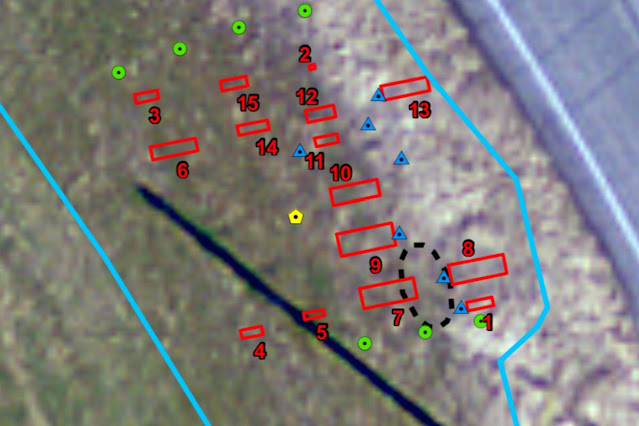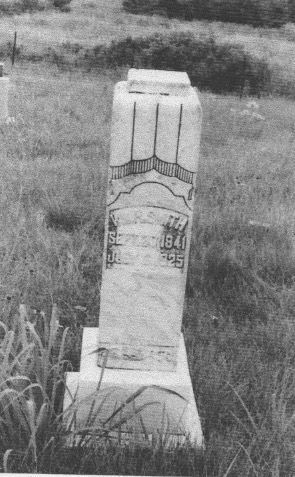Exhumed and Reburied After Cemetery Desecration
George Calvert: 1832-1855 (Second Cousin 3x Removed)
George Calvert seems to have been born under an unlucky
star. He suffered an unspeakable tragedy as a child, then died shockingly
young, and a century and a half later suffered the indignity of having his
grave desecrated.
George was born March 24, 1832 to parents Robert Patrick
Calvert and Lydia Jane Smith Calvert. He was the third of their five children. In
a previous blog post, I related how George’s father, Robert Calvert, beat his
mother, Lydia Jane Smith Calvert, to death, and yet was somehow was exonerated
at trial. George and his four siblings were taken in and raised by Robert
Calvert’s father Patrick.
George died October 2, 1855, while still living with his
grandfather. I have found no death records so have no idea what caused the
death of a 23 year old man. George was buried in a family cemetery on his
grandfather’s farm. The headstone was beautiful. At the top, framed by carved
drapery and a Bible, is a Bible verse reading, “Blessed are the dead who die in
the Lord.” The center panel includes George’s name and his birth and death dates,
while a panel at the bottom includes a lovely line of poetry: “So fades the
lovely blooming flower” attributed to C. Cross. It appears George was
well-loved.
 |
| Photo from Findagrave. Ken Colbert, photographer, |
But over the passage of time the tiny Calvert Farm Cemetery,
along with Patrick Calvert’s farm, passed out of family ownership, and the
story of the Calverts faded from memory. The Findagrave entry on the cemetery,
written by Calvert descendant Ken Colbert, tells part of the little cemetery’s sad
story:
“The Calvert Farm Cemetery was located at the
intersection of Hwy 65 and Nesbitt Station Road, on the Westside of the
intersection. The gravesite included 15 bodies buried from Aug 10, 1827 to Feb
14, 1861. Two of the removals included the analysis of DNA samples taken. The
graves were exhumed on April 2019 and relocated to Calvert Chapel Cemetery, approximately
2 miles North of the Calvert Farm Cemetery. Both Calvert cemeteries are located
in Armstrong Township, Vanderburgh County, Indiana. The patriarch of the
family, Patrick Calvert born, Feb 6, 1784 in Boutetort, VA was the last burial
occuring on Feb 14, 1861, laid to rest beside his wife, Sarah Martin Calvert,
born Dec 11, 1781 and died Aug 11, 1840. Subsequent family members have since
been interrned at Calvert Chapel. A detailed 101 page report is available on my
Ancestry.com account. The report identifies the process of exhumation,
analysis, and reinternment of the Patrick Calvert family. The details of why
the removal may be found in my ancestry account or by emailing:
seekandfind@att.net I am the 5th Greath Grandson of Patrick and Sarah Calvert.”

Cemetery had been on left side of road near intersection. Photo from Findagrave.
An article in the local newspaper, the Princeton Daily
Clarion on July 27, 2019, provides more details, as does a GoFundMe page Mr.
Colbert set up to help fund the exhumation and reburial of his ancestors. The
farm, including the cemetery, was put up for auction in 2006. In the years
following the sale, the headstones were desecrated—they were knocked down,
broken, and moved from the graves. The entire site was then plowed over and
farmed. The callousness of this farmer is shocking, especially since he was
aware of the cemetery when he purchased the land. He would have known exactly
how many acres of farmable land he was buying and the price would have
reflected that a parcel of the land was not farmable.
When the desecration became known, the county prosecutor’s office
became involved. According to the news article by Daily Clarion editor Andrea
Howe, the Vanderburgh County Prosecutor eventually brokered an agreement
between the landowner and the Calvert descendants to “have the location and
exhumation of the Calverts” funded. “An Indianapolis firm was commissioned to
perform an archeological dig at the property. Colbert said cadaver search dogs
were used to help identify the location of the bodies since there was no
visible sign of any grave.”
Mr. Colbert’s photos of the archeologists’ work are both
heartbreaking and fascinating. Mr. Colbert also prepared a diagram showing the
location of the graves and where the broken headstones ended up. George was
Burial No. 8. Mr. Colbert wrote: “The
Calvert Family Farm Cemetery plotting map of the exhumed 15 bodies. The green
circles represent the fence boundaries. The Blue represents the location of the
unearthed desecrated tombstones. The Red represents the burial site of each
person.”
The following photo shows some of the stones as they were
reassembled from the shattered pieces.
 |
| Photo by Ken Colbert, from Findagrave. |
The archeologists were able to recover George’s body.
Although this photo may seem a bit grisly, I think it is important to include
it. George was a person who was loved by his family. His remains deserved more
respect than they were given by a farmer eager for an extra acre. George’s
profile on Findagrave also includes a page from the archeology report describing his
gravesite, noting that nails, bricks, coffin screws and buttons were found
along with his remains.
According to the news article, the archeology team was able
to extract DNA samples from some of the exhumed remains, with the hope that the
DNA profiles will be uploaded to GEDMatch. Since George’s body was fairly
intact, perhaps his DNA will eventually help other genealogists trace their
family lineage.
While Calvert Farm Cemetery no longer exists, George Calvert,
his grandparents, and the other twelve people long interred on the Calvert farm
now have a new resting place in Calvert Chapel Cemetery, named for another
Calvert ancestor. Ken Colbert and other Calvert descendants are owed thanks for
their dedication and hard work that led to the recovery of the remains and the
headstones. Thanks is also owed to the firm that handled the exhumation—they showed
the remains of these Indiana pioneers the respect they deserved.
Sources:
Findagrave entries on the Calvert Farm Cemetery and on
George Calvert, all written by Ken Colbert. Photos of archeologists’ exhumation
by Ken Colbert. https://www.findagrave.com/cemetery/2705359/calvert-farm-cemetery
https://www.findagrave.com/memorial/209620211/george-calvert
GoFundMe page on reburial effort, prepared by Ken Colbert. https://www.gofundme.com/f/calvert-chapel-cemetery
“New Resting Place: Pioneer family remains to be reburied
after cemetery destroyed”, by Andrea Howe, Editor. Princeton Daily Clarion, 27
July 2019.















